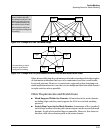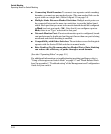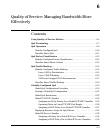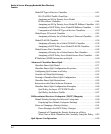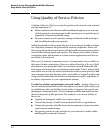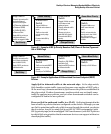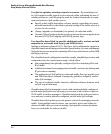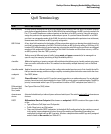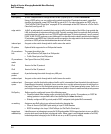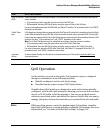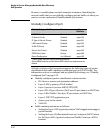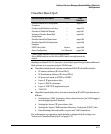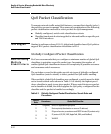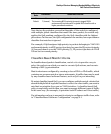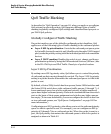
Quality of Service: Managing Bandwidth More Effectively
QoS Terminology
QoS Terminology
Term Use in This Document
802.1p priority A traffic priority setting carried by a VLAN-tagged packet moving from one device to another through
ports that are tagged members of the VLAN to which the packet belongs. An 802.1p priority can be from
0 to 7. The switch handles an outbound packet on the basis of its 802.1p priority, using the priority to
assign the packet to the appropriate outbound port queue. If a packet leaves the switch on a VLAN
port that is an untagged member of the VLAN, the priority is dropped and the packet arrives at the next,
downstream device without an 802.1p priority assignment.
802.1Q field A four-byte field contained in the header of Ethernet packets entering or leaving the switch through a
port that is a tagged member of a VLAN. This field includes an 802.1p priority setting, a VLAN tag, or ID
number (VID), and other data. A packet entering or leaving the switch through a port that is an untagged
member of the outbound VLAN does not have this field in its header and thus does not carry a VID or
an 802.1p priority. See also “802.1p priority”.
class Defines a set of different types of traffic (using match and ignore commands) to be managed in a
specific way (for example, prioritizing all High Availability traffic).
classifier Method of matching or ignoring certain traffic attributes that allows you to classify packets using more
than one traffic attribute at a time. This method can be used by multiple features, such as QoS and
mirroring.
classifier model Applied to various software features, this configuration model requires you to first classify the traffic
that you want to manage, and then configure a policy containing the actions to be executed on the class.
codepoint See DSCP, below.
CoS Class of Service. Priority level (0-7) used to transmit a packet on an outbound queue. For an individual
packet, class of service is determined by the Layer 2 802.1p priority value in a packet header. The 802.1p
priority is associated with a Layer 3 IP precedence bit-value or DSCP codepoint (see Table 6-11).
Differentiated
See Type-of-Service (ToS), below.
Services (Diff-
Serv) mode
downstream A device linked directly or indirectly to an outbound switch port. The switch sends traffic to
downstream
device
devices.
DSCP Differentiated Services Codepoint. (Also known as codepoint.) A DSCP consists of the upper six bits
of the:
• Type of Service (ToS) byte in an IPv4 packet
• Traffic Class byte in an IPv6 packet
• There are 64 possible DSCP codepoints. In the default QoS configuration for the switches covered
in this guide, some codepoints (such as Assured Forwarding and Expedited Forwarding) are
configured by default with an 802.1p priority. All other codepoints have no 802.1p priority assigned
and are listed as No-override (see Table 6-11).
6-7



